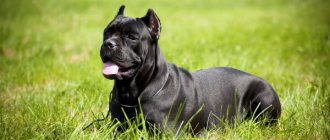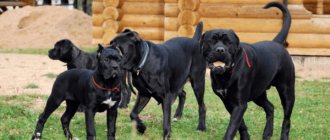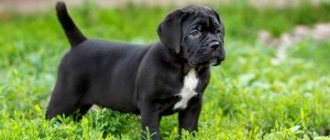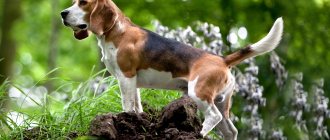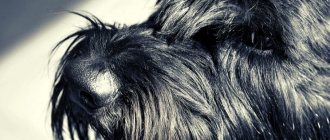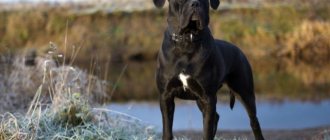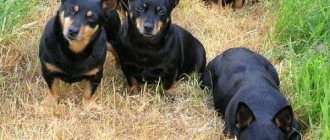The Cane Corso dog breed has grown in popularity over the past ten years.
Powerful, beautiful, strong dogs with satin hair and a calm disposition get along well in families with children, serve as companions for single people and are happy to share the difficulties of everyday sports with a sporty owner.
But in order for the pet to feel cozy and comfortable in the owner’s home, in order to avoid diseases and conflicts with family members, neighbors and pets, the owner must know everything about keeping a Cane Corso.
Brief characteristics of the Cane Corso dog breed
Male:
Bitch:
Price:
Life expectancy: 10–11 years, rarely lives up to 12 years. |
How difficult is the Cane Corso breed to maintain and care for? | Representatives of the Italian Cane Corso dog breed are easy to care for. She does not require exhausting loads, is clean, and, with proper upbringing, is non-aggressive. Can be both a companion and a working dog. |
Do you feel comfortable in an apartment or prefer a country house? Do you need an aviary? | Despite its large size, it is suitable for apartments and country houses. But the enclosure is not suitable for her. The breed requires constant contact with humans. In addition, people from warm Italy do not tolerate our winters well. If you decide to build an enclosure, make a warm booth in it. |
How often should you bathe? | If the pet does not participate in exhibitions, it is washed as needed, usually 2-4 times a year. A healthy dog has sebaceous glands that create a protective film on the coat. From frequent washing, the protection is washed away, and the glands hypertrophy. As a result, the coat becomes faded and greasy. |
Grooming. How often is it brushed? | This is a short-haired breed. But she still sheds. If you want to reduce the frequency of house cleaning, brush your Cane Corso regularly, especially during periods of heavy shedding. |
Is it suitable for a child? | The breed is well suited for families even with the smallest children. The pet patiently endures all the pranks of the kids. However, it requires firmness in education. It can be used by children aged 12–14 years. |
Frequency and duration of walks | The animal will be healthy and cheerful if you take it out for a walk for 1.5–2 hours every day. This is a powerful dog that needs exercise. In winter, she will happily take the children on sledding rides; in summer, she will play with a ball and run after fetch items. |
The playfulness of the Cane Corso | The breed is playful and pet friendly. |
Attitude towards family members, strangers, other animals | The owner for her is a king and a god rolled into one. The dog is friendly towards all family members. Be wary of strangers. Gets along well with other animals. |
Choosing a Cane Corso puppy
The Cane Corso dog breed is still considered rare and prestigious, so it is best to choose a dog from a kennel that specializes in breeding this breed. Before you make a purchasing decision, you should decide why you need a puppy. He can be just a pet, or he can become a participant in exhibitions or a future champion of the breed. The class of the puppy and, of course, its cost primarily depend on the purpose of the dog.
There are three classes of puppies:
- pet class;
- breeding class;
- show class.
For a beginner, raising show-class Cane Corso puppies is practically not suitable: buying such a dog, a potential champion, involves a very big responsibility. The future exhibitor and champion requires the highest quality care, a lot of attention and, as a result, appropriate experience is required. Pet-class puppies are a much better option in this regard, because the puppy will meet all the basic requirements of the breed, but the responsibility and price will be significantly lower.
As for the cost of dogs, it varies greatly depending on the class and place of purchase. So, in Cane Corso nurseries, a pet-class puppy can be bought for a maximum of $500. Breed-class animals will cost much more, in the range of $700-1000, and for a champion you need to be ready to pay $1000 or even more.
The easiest and cheapest option is to buy a puppy secondhand from an advertisement. But in this case, you need to prepare for any surprises: from congenital diseases to causeless aggression. Therefore, when choosing a puppy, you must first of all find a good kennel or breeder.
The owner of the nursery must, upon first request, provide all documents and complete information about the animal itself and its parents; show documents such as litter descriptions (including culling) and puppy cards. Each puppy must be branded, and a document must be drawn up for it, indicating its pedigree and vaccinations.
Judging by the photos from the kennel, the living conditions for Cane Corse puppies should be acceptable, but it’s worth checking for yourself by inspecting the premises where the dogs are kept.
The selected puppy, like other dogs in the kennel, must be healthy, active and moderately well-fed.
A good breeder worries not only about the health, but also about the future fate of the puppies. Therefore, he will probably ask a lot of questions to make sure that the buyer’s intentions are serious, as well as that the living conditions will be good. He will also agree to advise you on all questions that arise at any time, even after purchasing a puppy.
Advantages and positive assessment when choosing this breed
- The Cane Corso is an excellent watchdog. The pet will protect property and owners from uninvited guests.
- The dog is smart and disciplined, easy to train. She quickly grasps what her owner requires of her and tries to quickly carry out commands.
- Easy to train.
- The breed looks impressive and intimidating. With such a companion it is not scary to walk even in the most disadvantaged area.
- Corso is affectionate and obedient to its own people, distrustful of strangers, and poses a serious threat to them.
- Grooming for representatives of the breed is minimal: combing the coat during shedding, active walking and feeding.
- The animal becomes strongly attached to one owner.
Disadvantages of the breed
- Requires active walking. A leisurely half-hour walk on a leash will not be enough for her. A young individual can damage things in the house if left alone for a long time.
- This is a large breed, in the education of which relaxation is unacceptable. You need to train your puppy from an early age.
- Puppies require early socialization. Representatives of the breed are naturally distrustful of strangers. If you don't want to lock your dog up every time guests, a plumber or a mechanic comes, start training it as early as possible.
- An animal makes various sounds in its sleep (snoring, sniffling), which can be unpleasant if kept in an apartment.
- High price. Not everyone can afford to buy a purebred puppy. And crossbreeds and puppies from unplanned matings can have health problems.
Breed characteristics
Horse Corsos are considered intelligent dogs that demand respect. Aggression and abuse cause conflict and a complete loss of trust. A balanced character does not contain the beginnings of aggressiveness; the pet never attacks first or tries to bite.
Important! Even though the Cane Corso looks friendly, you should not touch him. In response to an invasion of personal space, he may become seriously angry and start barking. The guard cane corso is not a killer, but it can be very frightening with its huge grin.
Friendliness and attitude towards children
The Corso dog breed is characterized by a positive attitude towards younger family members. The innate qualities of a protector allow her not only to take part in children's fun, but also to constantly protect the kids.
An important difference from other relatives is that the pet really assesses the level of its strength and is aware of its own actions. During games, he does not knock the kids down, does not cause harm through negligence and does not frighten them.
Important! Before leaving a child with a dog, you need to clearly explain to him that the Cancor requires respect and good treatment. No patience is unlimited and aggressive behavior of children can bring unexpected and unpleasant consequences.
Attitude towards strangers
Cane Corso dogs are sincerely devoted and attached to their owner and family, and are ready to do anything for them. Strangers should remember this feature and try to behave extremely carefully and politely. Any sudden movements can alert the pet, which with one growl will indicate the impossibility of such actions in the presence of a person close to him.
Corsairs are not stupid or gullible; they never take delicacies from the hands of others. It is impossible to persuade them to go with you; they constantly divide those around them into friends and strangers.
Important! If a feeling of danger comes from a stranger and the pet hears it, it will instantly switch its attention to the suspicious object. In case of obvious aggression, he will first try to warn him with a growl, and if there is no reaction, he may attack.
Negative emotions
Security and guard qualities
Canes are considered smart and kind animals that lack pronounced aggressive behavior. These qualities do not prevent him from ideally performing the function of a guard not only of his owner, but also of his house and territory.
Cane Corso perfectly sense both the danger itself and its approach. They react instantly to the appearance of an intruder, and the iron grip of their jaws allows them to hold the unlucky thief until the owner arrives.
Important! The four-legged dog hates uninvited guests, so it is better not to cross the border of private property without its rightful owner.
Cane Corso: dog character
According to the description of the Cane Corso breed, it has a typical Molosser character. It has the following features:
- mental balance is predictable, she does not have sudden outbursts of aggression, she knows how to wait for a command;
- boundless devotion to the owner - with proper upbringing, even a three-year-old child can command a huge dog;
- strong guard qualities - the character is genetically based on the desire to protect the perimeter of a house, apartment, yard, and reacts severely to the appearance of strangers, however, a well-trained dog always lets go of the victim if it stops moving or the owner’s command is heard;
- a combination of external equanimity and playful temperament - they are actively involved in the game, young Corsos may not even hear the owner’s commands, but adult dogs behave sedately, their endurance can be envied;
- dependence of character on color - breeders note that gray individuals are more aggressive, like representatives of the brindle breed. They have a more domineering character.
Behavior at home
He gets along with all the inhabitants in the house. She usually gets along with children and other pets. This trait has deep roots. She was adopted back when Corsos were herding dogs. Since then they have been trying to establish contact with other representatives of the fauna. Even if the older pet shows aggression, the Corso will patiently wait for a reason to make friends with him.
The owners note that the Corso can be a nanny for small children. However, such a teacher should not be left unattended with the baby. And don’t forget to teach your children how to behave around a dog.
Behavior on the street
The herding past left another imprint on the character of the Cane Corso: she loves to patronize. If the family decides to go on a picnic, the pet will do everything possible to ensure that no one gets lost. He will always keep his “herd” under control. At the same time, he has no jealousy or selfishness, which is rare for Molossians.
Attitude towards strangers, protection of the owner and home
Well-trained adults react calmly to passers-by, strange dogs and other animals. This breed has retained the ability to evaluate the slightest changes in the behavior of others. If they begin to behave aggressively, the Corso turns from an easy-going companion into an angry protector.
Usually, if the owner is friendly to the stranger, she also behaves calmly. Her usual position is between the owner and the stranger. She watches every move, not letting anyone forget about herself.
However, poorly behaved dogs may not allow strangers near their owner and may attack cyclists, runners, and passers-by. Pets with whom they don’t walk a lot can behave the same way. A bored animal becomes irritable. Your pet will find something to do without you, but you are unlikely to like it.
Purpose of the Cane Corso breed
Initially, the Cane Corso was used as a guard dog, with strength, courage and aggression strong enough to fight with a large animal. The cultivation of these qualities in the breed led to the fact that the dogs were extremely vicious. When the breed became popular and was significantly diluted with the blood of local, less aggressive dogs, it began to be used in many forms.
The Cane Corso is a companion dog that excels at guarding the home and family.
Italian peasants and farmers demanded from their pets the ability to herd sheep and look after horses, guard livestock and houses, and also behave discreetly and friendly with numerous children. Over the centuries, these skills have been improved, and as a result, the dog has become a true friend and faithful companion of man, a sensitive watchman and an affectionate pet. Today, the Cane Corso is successfully used as a companion dog, capable of not only becoming a real family member, but also being a reliable guard and bodyguard.
Care and maintenance
The existing characteristics of the Cane Corso breed and reviews from experienced dog breeders allow us to conclude that with proper walking, the Corso will feel good in any living space. Year-round keeping outside is not recommended. If the animal is in an enclosure in winter, it needs to be provided with a warm place to sleep. This is a short-haired breed. She has a small undercoat, but it will not keep her warm in cold weather. The Corso is also not suitable for the role of a chain dog. He has too great a desire to communicate with people and a very freedom-loving character.
Grooming
The dog does not need haircuts. From time to time it is simply combed out with a special brush. Wool does not have an unpleasant specific odor. The pet does not create discomfort for the inhabitants of the house. It is washed several times a year. The rest of the time, the coat is cared for by wiping it with a rubber brush or a damp towel.
Nail care
An actively walking dog does not need to have its nails trimmed. She wears them down during walks. It is enough to keep them clean by wiping their paws with a damp cloth after going outside. But if you hear a characteristic clicking sound on the floor, you will have to give her a pedicure using special tweezers.
Eyes and ears
According to the standard, the lower eyelid should not be too saggy. If your pet's eyes are excessively wet, you need to make sure that there are no discharge or crusts in the corners of the eyes. Healthy ears do not smell and are always clean.
According to the breed standard, dropped and cropped ears are allowed. In our country, docking is allowed. It is better to do this before 4–5 months of age. Please note that in most countries this operation is prohibited, and dogs with cropped ears cannot participate in international exhibitions held in their territory.
Teeth
If the owner adheres to the recommended diet, then there should be no problems with teeth. Check your pet's teeth from time to time and give him treats to combat tartar.
Vaccinations
The vaccination schedule must be drawn up by a veterinarian. As a rule, puppies are vaccinated at least 2 times a year; adults only need to receive a polyvalent vaccine once a year.
Conditions for keeping Corso
The Cane Corso breed is a healthy breed, so these dogs do not require special conditions of keeping and care for them. Canes get along quite comfortably in an apartment, but it is worth remembering that this is not the best housing option.
Ideally, the dog needs plenty of space for active play and running. It is best to keep your dog outside, in a kennel.
Thanks to its activity, the Corso can withstand temperatures down to -25 °C well, but in case of lower temperatures the booth should be well insulated. You should not put your Corso on a chain - these dogs are very sociable, they need constant communication, so they will simply “wither away” on a chain.
A dog living on the street does not need special care. The main thing is to provide him with adequate nutrition to make up for the lack of calories for such an active dog. Food should be rich in minerals and vitamins. A vitamin complex can be recommended by a veterinarian. If you decide to feed your dog dry food, then you need to choose high-quality, premium food. Which one is better to buy - you can consult with other Cane Corso owners on the forum.
The main concern of the owner is to provide his dog with sufficient physical activity. For this reason, the Cane Corso is not suitable only for older people, because walks should not be reduced to the usual laps around the park at a slow pace. Even from the description of the Cane Corso, it is clear that a walk for these dogs means fun, following commands, active games and running for sticks or balls. The Corso also loves to accompany its owner on hikes, jogs and bike rides.
What to feed
The Cane Corso's diet should be tailored to the pet's activity and age. It must be balanced. This is achieved in different ways. Typically, owners opt for either natural feeding or buy ready-made food.
It is important that the bowl of food is placed at chest height, and that the pet does not bend over while eating. You cannot leave food in the bowl after eating; from puppyhood, the animal must be taught to order.
Puppy diet
Starting from 3 weeks of age, the puppy is accustomed to a normal feeding diet. You need to create a feeding schedule for your puppy. Babies are given food 3–6 times a day, gradually transferring puppies to the 2 meals a day diet of an adult dog. The portion is determined individually by observing behavior. If the puppy eats everything and calmly goes to his place, then the amount of food is suitable for him. If after feeding the puppy's belly is swollen and lethargic, it means he has overeaten.
Protein food
Suitable protein sources:
- lean meat (veal, beef, chicken, rabbit);
- fish (preferably sea fish, river fish may contain helminth eggs);
- cottage cheese;
- eggs;
- milk.
Until 10 weeks of age, food is crushed. Raw beef or veal meat is scraped, boiled chicken and rabbit are ground in a blender. It is useful to give puppies the blood of slaughter animals (from 2–3 months). Meat products are introduced into the diet from 5–6 months of age. When changing teeth, young dogs are given beef bones. Meat is added at every feeding. It is combined with vegetables and cereals.
Fish should be given carefully. No need to mix it with meat. It is better to alternate meat meals with fish. To do this, all the bones are removed from the fish, the river species are boiled, the sea species can be given raw, everything is crushed. It is given 1-2 times a week to puppies from 4 months.
Raw eggs are given to puppies along with other food, while protein is completely excluded from the diet. The yolk can also be given boiled. Milk is good for puppies. It is given raw or porridge is cooked on it. From time to time, milk can be replaced with curdled milk. It is useful to give non-acidic cottage cheese.
Sources of fats
Cane Corso puppies need animal and plant fats. Their sources may be:
- milk, sour cream;
- butter;
- vegetable oils;
- beef fat.
The daily fat intake for puppies up to one year is 2.6–2.7 g per 1 kg of animal weight. Fats are added to cereals, vegetables, and mixed with lean meat. With a lack of fat, puppies are stunted in growth. Excessive consumption of fatty foods can lead to disruption of certain functions, causing the animal to become inactive and lethargic.
Carbohydrate foods and vitamins
For normal development, puppies need sugar, fiber, and starch. These substances are contained in:
- cereals (pearl barley, wheat, buckwheat, oatmeal, semolina, barley, corn, rice);
- bread, bran;
- vegetables (carrots, beets, cabbage);
- fruits and vegetables;
- honey
The puppy's daily diet should include 15–16 g of carbohydrates per 1 kg of the puppy's weight. To feed Cane Corso puppies 2 months old, cereals are crushed and brewed with hot milk. After cooling, feed it to the puppies. Starting from 4 months, Corso puppies are given cut. Whole grains are suitable for dogs aged 6 months and older.
You need to be careful with oatmeal. It is given once a week. Addiction to this product provokes inflammation of the anal glands. Legumes are not suitable for them either. They are poorly digestible by both puppies and adults. The exception is soy; it can be added in crushed form to porridge and vegetable salads.
Adult dog diet
The diet of an adult dog is not very different from the diet of a puppy. It's all about the amount of food. An adult Cane Corso requires 20–40 g of dry food per day (depending on body condition) and 30–60 g of liquid food with a significant water content.
The diet largely depends on how the dog is used. Service dogs need more energy, which means they will also need more proteins/fat/carbohydrates.
An animal weighing 50 kg should consume daily:
- 220–230 g proteins;
- 60–70 g fat;
- 460–470 g carbohydrates;
- 35–40 g fiber;
- 1 liter of water;
- 30 g of mineral mixtures.
You cannot give:
- fresh bread;
- pork;
- lentils, peas, beans;
- spicy and salty foods;
- smoked meats;
- dishes from your table.
Training and education
The formation of a dog occurs in the first 3 months. During this period, the puppy needs communication more than ever. Provide for him or he will have behavior problems. He must understand from the first days that you are a teacher, and he is a student. But keep in mind that each puppy is an individual.
The Cane Corso is easy to train. The success of your puppy following commands depends entirely on your desire and determination. At least 20 minutes a day should be devoted to exercising with your pet. It is not at all necessary to teach your puppy the typical commands “fu”, “near”, etc. You can use your own words: “go”, “spit it out”, “give”.
The little Corso learns them well during play. But any abilities can be either developed or suppressed. If you do not have experience raising dogs, contact instructors. They will teach you how to properly handle this breed.
It is not reasonable to expect your baby Corso to behave like an adult dog. And this breed is characterized by slow maturation. Character is established only by the age of two. And do not confuse training with education. Raising a puppy begins from the moment it appears in the house, and Cane Corso training is done only with an older and stronger dog (usually from 5 months), since some techniques involve harsh influence on the pet.
To the house with clean paws and manicure
When a Cane Corso lives in an apartment or in a house with an owner, you should always wash his paws after a walk. It doesn’t matter whether it’s dry outside or raining – the rule is immutable.
Claw care is a separate concern. Too long nails will bother the dog, and they can also grow into the flesh or break, injuring the paws. If a Cane Corso spends a lot of time outside, it will naturally wear down its claws on road surfaces. Then additional care may not be needed. However, you still need to inspect the paws.
If necessary, the claws are trimmed with a special tool - a nail clipper. It is sold in pet stores. Just pay attention to the quality of the product. If the blade is dull, the claw will simply crumple, and then peel off and cling to everything. This is fraught not only with inconvenience for the dog, but also with injuries. Before the procedure, the nail clipper must be disinfected. After trimming, the claws are treated with a nail file.
You can’t trim your Cane Corso’s nails without preparing him mentally. To do this, you need to train for several days - lay the dog down as before a haircut, touch the nails so that it understands the safety of the procedure. Be calm and patient, otherwise the first time will end in a battle of the titans and will be the last.
Sometimes when your dog's nails are trimmed, your dog will bleed. This means you grabbed too much. There is nothing catastrophic about this, but the claw needs to be lubricated with iodine, sealed with a band-aid, or better yet, with special glue.
You don’t need to trim much, just the tip, placing the nail clipper not from the inside of the paw, but from above, at an angle of about 45 degrees. It is easy to determine the border of the haircut: as soon as you see a dark point inside the claw, stop - this is the main vessel.
Haircut is not the only task. You need to pay attention to the condition of the claws. They should not break, crack, or peel. If this happens, try lubricating them with natural animal fat. If there is no effect, the Cane Corso may not be getting all the nutrients it needs from its food. Contact your veterinarian to review your diet or choose vitamin and mineral supplements.
If you liked the article, be sure to like it. Share your impressions and experiences in the comments. This will be useful to other Cane Corso owners and to us to make the site even better.
Choosing and caring for a puppy
Before you buy a Cane Corso puppy, you need to ask the breeder for x-rays of the baby’s parents confirming the absence of dysplasia from the producers.
The selected puppy must be:
- moderately curious;
- playful;
- have shiny fur and clear eyes;
- have the correct bite.
The gender of the puppy is an important aspect of choice. Bitches have a more flexible character, they are easier to train, and are more suitable for women. Males have a more quarrelsome character.
Preparing for the arrival of a puppy in the house
First you need to decide on a nursery. Then set up a place for the puppy, buy a bed, a bowl, and food. Set aside a quiet place for the new member of your family. He should feel safe there, but don't separate him from his family. The puppy must see what is happening around.
Immediately show him his territory and explain what he is allowed to do. Do it calmly, without hysterics. If the puppy does something wrong, punish him; if he did everything right, praise him and give him a treat.
Teach your baby to hygiene from the first days. He shouldn't leave puddles all over the house. A small Cane Corso can wear diapers. But don't prolong this period. Try to take your puppy outside immediately after sleep. After he does all his work, praise him. And soon he himself will ask to go outside.
Breed standards
A thorough description of the dog's behavior and characteristics of the Cane Corso breed was compiled at the beginning of the 16th century and published in a treatise on zoology by the Swiss Gesner Conrad, the author of the first modern treatise on zoology.
| Usage | Guard, protection, police and herding dog. |
| Appearance | A large animal with a strong, powerful and elegant body. She has clearly defined, sculpted muscles. |
| Temperament, behavior | A security guard with a balanced character. In the past it was used for grazing livestock and hunting big game. |
| Head |
|
| Frame |
|
| Limbs |
|
| Gait |
|
| Wool |
|
| Color |
|
| Height |
|
| Flaws |
|
| Significant disadvantages |
|
Origin story
The ancestors of the breed are Molossian dogs. In ancient times, Cane Corsos served as guards, took part in battles and military operations, and tended herds. As time passed, firearms began to be used in battles, and the need for military dogs disappeared. Already at the beginning of World War II, the number of animals decreased significantly.
Today Italians call the Cane Corso their pride. However, despite its cultural and historical significance, the breed was on the verge of extinction even in Italy. It was preserved by a group of enthusiasts who went in the 70s of the last century to look for preserved individuals to where the breed originated - to Locatia, Puria, Sicily.
They managed to preserve the ancient beauty. The breed was officially recognized by the Italian Canine Association in 1994, and in 1996 by the international organization FCI. In 1999, the Association of Italian Cane Corsos was founded. The standard was adjusted and came into force in 2003. It is still used today by the International Cane Corso Federation.
History of the Cane Corso breed
These animals are descendants of the ancient Roman Molossians, descended from the Etruscan Great Danes, Macedonian and Persian fighting dogs. Translated from Italiano, “cane” means dog, “corso” means war horse, yard, guard. The name itself confirms that the dogs were guards, watchmen and warriors. In ancient Rome, Cane Corsos were used as fighting baiting dogs in gladiator battles. Animals were also kept in their homes by Roman patricians as decoration and as companions. If necessary, animals could look after children. Patricians idolized their pets.
After the collapse of the Roman Empire and until the Middle Ages, the animal was not mentioned anywhere, but, judging by the images in ancient engravings and tapestries, the Roman Molossians spread throughout Europe. During the Renaissance, these persistent and fearless animals became famous for their victories in fights with wild animals - lions and bears. They were sculpted by sculptors and painted by artists. Italians still say to this day: “Brave is like a Corso.” Before the 1941 war, dogs were used as farm guards and livestock guards. Dogs were not used for fighting, but their strong jaws were needed in many areas. During the war, a large number of dogs died and they were in danger of extinction.
Italian breeders could not allow the death of unique animals and, relying on their own enthusiasm, saved and revived the breed. In 1976, lovers of these amazing dogs, inspired by the literary work of the researcher Breber, created the Societa Amatori Cane Corso (SACC) association. But as an independent breed it was recognized only in 1994 in Italy and in 1996 by the FCI. Its prototype was the male Boris.
